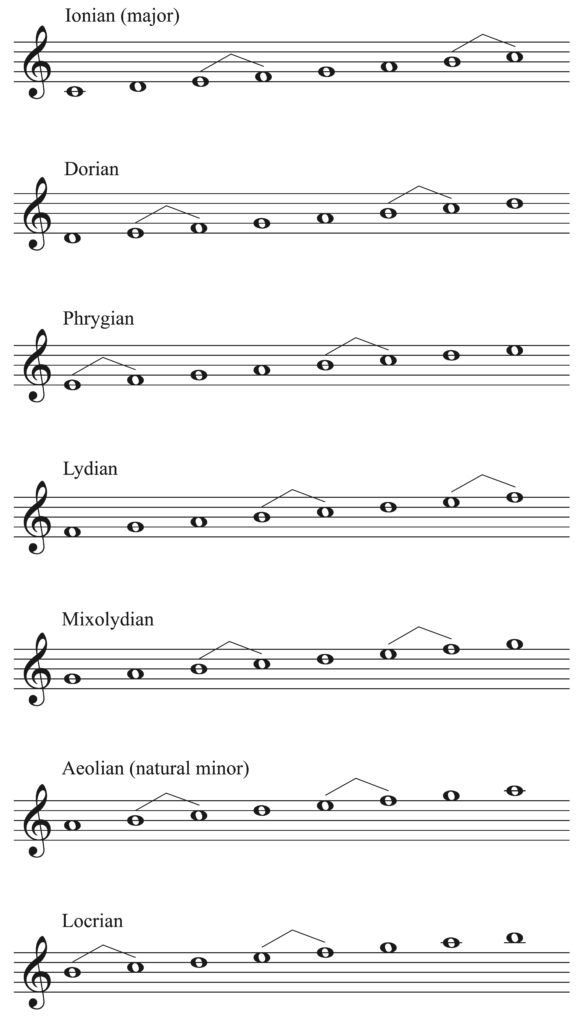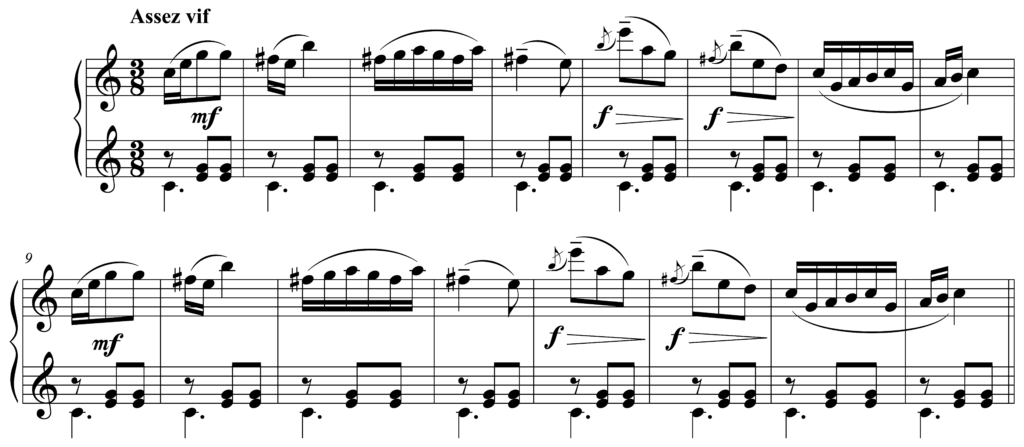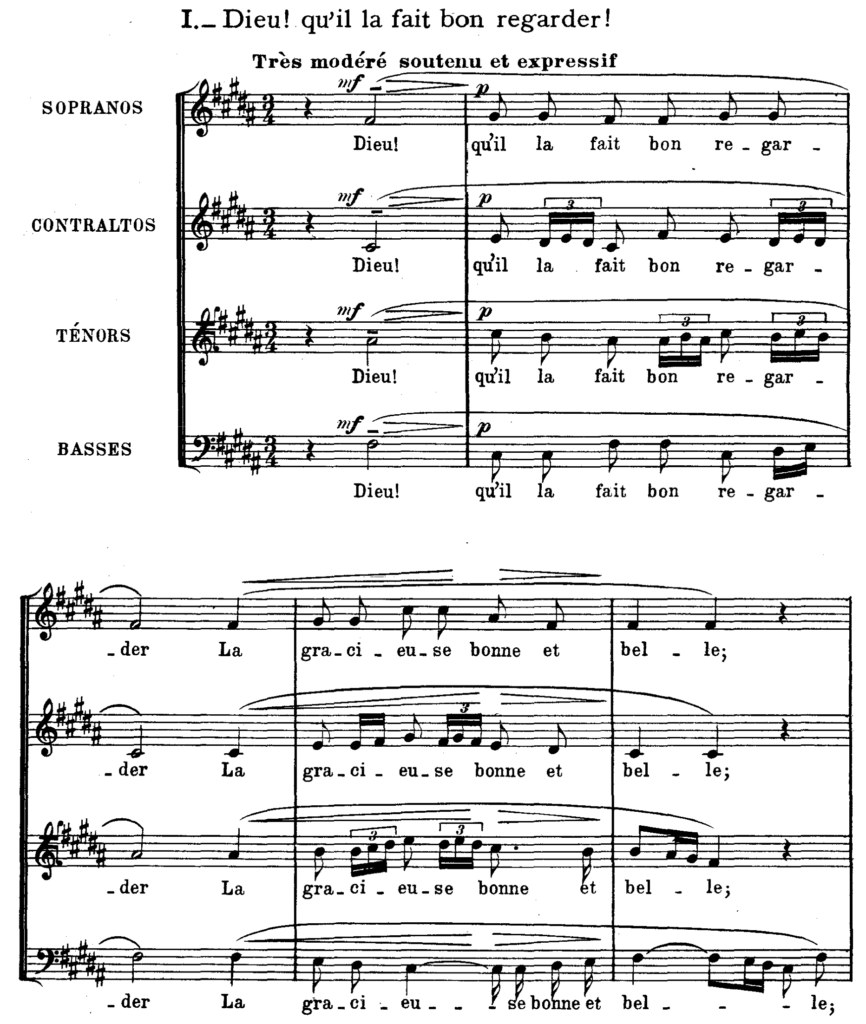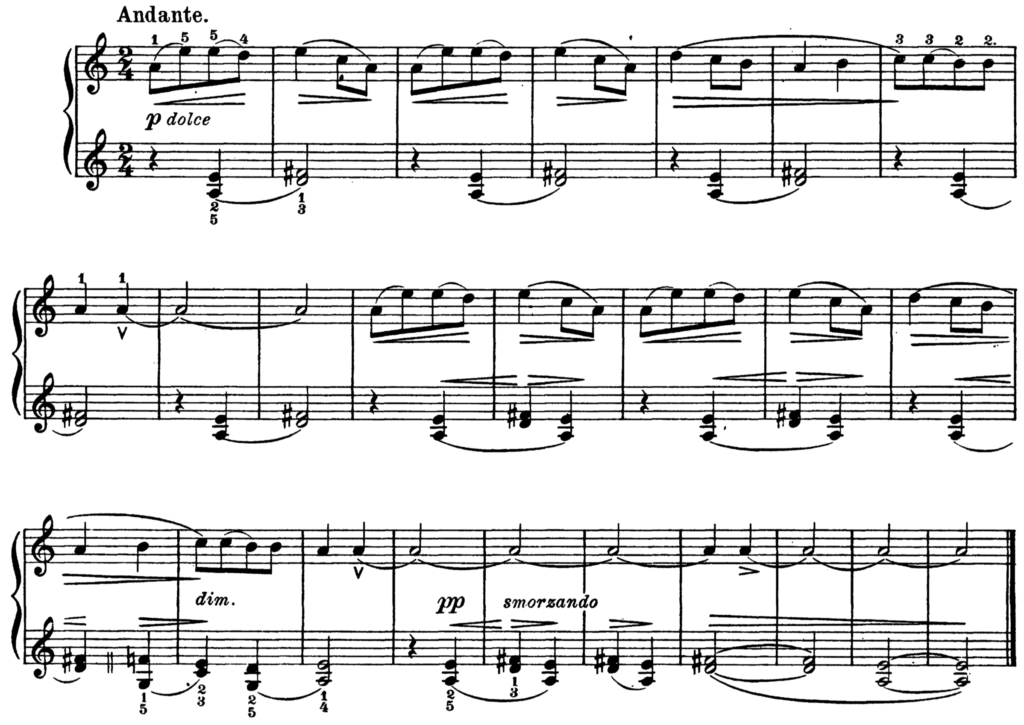Main Body
8 Modes and other scales
Learning goals for Chapter 8
In this chapter, we will learn:
- How to construct the four most commonly used church modes outside of (major) and (natural minor)
- How to construct and scales
- How these scales work in musical contexts
- How to sing these scales
- How to identify these scales by ear
Modes
The names of the (seven-note) come from a system developed in the Middle Ages by monks to classify different chants by their melodic properties. The original understanding of what constitutes a mode involved not just a particular configuration of whole and half steps, but also particular turns of phrase and special melodic characteristics. Modal music gradually fell out of fashion in the early Baroque period, as what we call common practice tonality (the major and minor scales) slowly set in. Late nineteenth- and twentieth-century composers returned to using modes as a way to find “new” compositional techniques, but generally they used them as pitch collections or scale types, without any particular set of melodic turns of phrase as they once had in medieval times. Modes are used today in some concert music as well as in popular genres, especially jazz.
According to this classification system, another term for the major scale is , and the modal term for natural minor is . Since we already studied these scales in previous chapters, this section focuses on the four most common modes outside of major and minor: , , , and . The mode is part of this theoretical system, but it is used infrequently, so we will not study it here.
We can understand each mode as fitting into one of two broad categories: pseudo-major and pseudo-minor. The pseudo-major modes, and , resemble the major scale in that they feature a major third between scale degrees ![]() and
and ![]() , whereas the pseudo-minor modes resemble the natural minor scale because they feature a minor third between scale degrees
, whereas the pseudo-minor modes resemble the natural minor scale because they feature a minor third between scale degrees ![]() and
and ![]() . Example 8‑1 shows the major scale and two modes that feature a major third between scale degrees
. Example 8‑1 shows the major scale and two modes that feature a major third between scale degrees ![]() and
and ![]() .
.
is similar to major except that its subdominant scale degree is raised by one chromatic half step, and thus uses “fi” instead of “fa.” is similar to major except that it uses the subtonic scale degree (“te”) instead of the leading tone (“ti”).
Example 8‑2 shows the natural minor scale and two modes that feature a minor third between scale degrees ![]() and
and ![]() . is similar to natural minor except that its supertonic scale degree is lowered by one chromatic half step, and thus uses “ra” instead of “re.” is similar to natural minor except that its submediant scale degree is raised by one chromatic half step, using “la” instead of “le.”
. is similar to natural minor except that its supertonic scale degree is lowered by one chromatic half step, and thus uses “ra” instead of “re.” is similar to natural minor except that its submediant scale degree is raised by one chromatic half step, using “la” instead of “le.”
Video: T16 Intro to modes (6:51)
This video provides an overview of the four modal scales–dorian, phrygian, lydian, and mixolydian.
Each mode can also be mapped onto the white keys of the piano as a relative mode to C major (no sharps or flats), as shown in Example 8-3.
Modes in context: the lydian mode
Video: T17 Exploring the lydian mode (7:30)
This video examines the use of lydian mode in a piece by Francis Poulenc, the theme song from the TV show The Simpsons, Björk’s “Unravel,” and two versions of Carole King’s unpopular song “He Hit Me” by the Crystals and Grizzly Bear. To go through these examples on your own, see Exercise 8-1.
EXERCISE 8-1 Lydian in context
The lydian scale is like major with a raised scale degree ![]() (fi).
(fi).
C lydian. Write the C lydian scale below or on a separate piece of staff paper. Select the right arrow over the image to view the answer.
Listen to and study its use in the following examples.
Worksheet example 8‑1 Francis Poulenc, “Valse,” mm. 1–16
Learn about French composer Francis Poulenc (1899–1963) by reading this Oxford Music Online article, written by Myriam Chimènes and Roger Nichols.
Worksheet example 8‑2. Danny Elfman, theme from The Simpsons, 0:00–0:16
Worksheet example 8‑3. Björk, “Unravel,” 0:00–0:38
G lydian. After writing the G lydian scale below or on a separate sheet of staff paper, listen to and study its use in Worksheet example 8‑4. Select the right arrow over the image to view the answer.
Worksheet example 8‑4. The Crystals, “He Hit Me,” 0:00–0:30
Listen to the full track on Spotify.
Learn about American songwriter Carole King (b. 1942) by reading this Oxford Music Online article, written by Richard D. Driver.
Learn about 1960s American vocal quintet the Crystals by reading this Oxford Music Online article, written by John Clemente.
F lydian. Compare the previous example to Worksheet example 8‑5 after writing the F lydian scale below or on a separate sheet of staff paper. Select the right arrow over the image to view the answer.
Worksheet example 8‑5. Grizzly Bear, “He Hit Me,” 0:00–0:36
Modes in context: the mixolydian mode
Video: T18 Exploring the mixolydian mode (6:16)
This video shows how the mixolydian mode is used in music by Claude Debussy, the Beatles, and Guns N’ Roses. To go through these examples on your own, see Exercise 8-2.
EXERCISE 8-2 Mixolydian in context
The mixolydian scale is like major with a lowered scale degree ![]() (te).
(te).
F![]() mixolydian. After writing the F
mixolydian. After writing the F![]() mixolydian scale below or on a separate sheet of staff paper, listen to and study its use in Worksheet example 8‑6. Select the right arrow over the image to view the answer.
mixolydian scale below or on a separate sheet of staff paper, listen to and study its use in Worksheet example 8‑6. Select the right arrow over the image to view the answer.
Worksheet example 8‑6. Claude Debussy, Trois Chansons, no. 1, mm. 1–5
Listen to the full track, performed by the Robert Shaw Festival Singers, on Spotify.
Read an English translation of the song text on lieder.net.
Learn about French composer Claude Debussy (1862–1918) by reading this Oxford Music Online article, written by François Lesure and Roy Howat.
E mixolydian. After writing the E mixolydian scale below or on a separate sheet of staff paper, listen to and study its use in Worksheet example 8‑7. Select the right arrow over the image to view the answer.
Worksheet example 8‑7. The Beatles, “Day Tripper,” 0:00–0:24 (audio)
Listen to the full track on Spotify.
Learn about 20th-century English rock band the Beatles and their music by reading this Oxford Music Online article, written by Walter Everett.
C![]() mixolydian. After writing the C
mixolydian. After writing the C![]() mixolydian scale below or on a separate sheet of staff paper, listen to and study its use in Worksheet example 8-8. The chord progression in this example is derived from the C
mixolydian scale below or on a separate sheet of staff paper, listen to and study its use in Worksheet example 8-8. The chord progression in this example is derived from the C![]() mixolydian scale. Select the right arrow over the image to view the answer.
mixolydian scale. Select the right arrow over the image to view the answer.
Worksheet example 8-8. Guns N’ Roses, “Sweet Child O’ Mine,” 0:15–0:31 (audio)
Listen to the full track on Spotify.
Learn about 1980s American rock band Guns N’ Roses by reading this Oxford Music Online article, written by Rob Jovanovic.
Modes in context: the phrygian mode
Video: T19 Exploring the phrygian mode (8:16)
This video explores examples of the phrygian mode in music by Benjamin Britten, Brian Eno, Björk, and Britney Spears. To go through these examples on your own, see Exercise 8-3.
EXERCISE 8-3 Phrygian in context
The phrygian scale is like natural minor with a lowered scale degree ![]() (ra).
(ra).
G phrygian. After writing the G phrygian scale below or on a separate sheet of staff paper, listen to and study its use in Worksheet examples 8‑9 and 8-10. Select the right arrow over the image to view the answer.
Worksheet example 8‑9. Benjamin Britten, “In Freezing Winter Night,” opening
Listen to the full track, performed by the Choir of King’s College, Cambridge, on Spotify.
Learn about English composer Benjamin Britten (1913–1976) by reading this Oxford Music Online article, written by Philip Brett and others.
Worksheet example 8-10. Brian Eno, Neroli
Listen to the track on Spotify.
Learn about English composer, sound artist, and producer Brian Eno (b. 1948) by reading this Oxford Music Online article, written by David Buckley and revised by Cecilia Sun.
C![]() phrygian. After writing the C
phrygian. After writing the C![]() phrygian scale below or on a separate sheet of staff paper, listen to and study its use in Worksheet example 8‑11. Select the right arrow over the image to view the answer.
phrygian scale below or on a separate sheet of staff paper, listen to and study its use in Worksheet example 8‑11. Select the right arrow over the image to view the answer.
Worksheet example 8-11. Transcription of Björk, “Where Is the Line,” 0:00–0:19
A phrygian. After writing the A phrygian scale below or on a separate sheet of staff paper, listen to and study its use in Worksheet example 8‑12. This example features the descending phrygian scale, and lowered scale degree ![]() occurs on the word “seek” and the first syllable of “Amy.” Select the right arrow over the image to view the answer.
occurs on the word “seek” and the first syllable of “Amy.” Select the right arrow over the image to view the answer.
Worksheet example 8‑12. Britney Spears, “If U Seek Amy,” 0:45–1:00
Listen to the full track on Spotify.
Learn about American pop singer Britney Spears (b. 1981) by reading this Oxford Music Online article, written by Jessica Brown.
Modes in context: the dorian mode
Video: T20 Exploring the dorian mode (8:38)
In this video we explore the use of the dorian mode in music by Béla Bartók, Miles Davis, Radiohead, and Led Zeppelin. To go through these examples on your own, see Exercise 8-4.
EXERCISE 8-4 Dorian in context
The dorian scale is like natural minor with raised scale degree ![]() (la).
(la).
A dorian. After writing the A dorian scale below or on a separate sheet of staff paper, listen to and study its use in Worksheet example 8‑13. Select the right arrow over the image to view the answer.
Worksheet example 8-13. Béla Bartók, Little Pieces for Children, no. 3
Learn about Hungarian composer Béla Bartók (1881–1945) by reading this Oxford Music Online article, written by Malcolm Gillies.
D dorian. After writing the D dorian scale below or on a separate sheet of staff paper, listen to and study its use in Worksheet example 8‑14. Select the right arrow over the image to view the answer.
Worksheet example 8-14. Miles Davis, “So What,” 0:34–1:05
Listen to the full track on Spotify.
Learn about American jazz trumpeter and bandleader Miles Davis (1926–1991) by reading this Oxford Music Online article, written by Barry Kernfeld.
A![]() dorian. After writing the A
dorian. After writing the A![]() dorian scale below or on a separate sheet of staff paper, listen to and study its use in Worksheet example 8‑15. Select the right arrow over the image to view the answer.
dorian scale below or on a separate sheet of staff paper, listen to and study its use in Worksheet example 8‑15. Select the right arrow over the image to view the answer.
Worksheet example 8‑15. Radiohead, “15 Step,” 0:41–1:00
Listen to the full track on Spotify.
Learn about English rock band Radiohead by reading this Oxford Music Online article, written by Christopher Doll.
E dorian. After writing the E dorian scale below or on a separate sheet of staff paper, listen to and study its use in Worksheet example 8‑16. Select the right arrow over the image to view the answer.
Worksheet example 8‑16. Led Zeppelin, “Whole Lotta Love,” 0:00–0:40
Listen to the full track on Spotify.
Learn about English rock band Led Zeppelin by reading this Oxford Music Online article, written by Susan Fast.
Modes in action
Video: T21 Singing demo of the modes in action (5:00)
This video shows how to take a tune in major and transform it into the four diatonic modes: lydian, mixolydian, dorian, and phrygian.
Want practice identifying different scales by ear? Try these drills:
Scale ID ear trainer (tone savvy)
Scale ID ear trainer (musictheory.net)
Whole tone scales
Scales other than major, minor, and the modes exist, and in fact, you can even invent your own scales by rearranging the order of half and whole steps.
Two other types of scales are found in some Western classical and popular music: the and the . The whole tone scale consists of a series of whole steps, with no half steps at all. There are only two distinct whole tone scales (shown in Example 8-4), since starting on any note produces one collection of pitches or the other. The notes in parentheses are alternate spellings of certain members of the scale. Since there are no half steps in the whole tone scale, it is difficult to perceive any sense of tonic or strong primacy of one note over another. Because of this, the scale is flexible in terms of spelling, unlike major scales, minor scales, and the diatonic modes.
Video: T22 Whole tone scales (8:55)
This video introduces the concept of whole tone scales and presents examples of its appearance in works by Mozart, Debussy, Kraftwerk, and Bartók. To go through these examples on your own, see Exercise 8-5.
EXERCISE 8-5 Whole tone scales in context
The whole tone scale is built entirely on whole steps.
G whole tone. After writing the G whole tone scale below or on a separate sheet of staff paper, study and listen to its use in mm. 75–77 in Worksheet example 8‑17. Select the right arrow over the image to view the answer.
Worksheet example 8‑17. W. A. Mozart, Ein Musikalischer Spaß, K. 522, mvt. 3, mm. 74–81, violin 1
Listen to the full track, performed by the Chamber Music Society of Lincoln Center, on Spotify.
Learn about Austrian composer Wolfgang Amadeus Mozart (1756–1791) by reading this Oxford Music Online article, written by Cliff Eisen and Stanley Sadie.
E whole tone. After writing the E whole tone scale below or on a separate sheet of staff paper, study and listen to its use in Worksheet example 8-18. Select the right arrow over the image to view the answer.
Worksheet example 8-18. Claude Debussy, Voiles, mm. 1–4

Listen to the full track, performed by Arturo Benedetti Michelangeli, on Spotify.
Learn about French composer Claude Debussy (1862–1918) by reading this Oxford Music Online article, written by François Lesure and Roy Howat.
F![]() whole tone. After writing the F
whole tone. After writing the F![]() whole tone scale below or on a separate sheet of staff paper, study and listen to its use in Worksheet example 8‑19. Select the right arrow over the image to view the answer.
whole tone scale below or on a separate sheet of staff paper, study and listen to its use in Worksheet example 8‑19. Select the right arrow over the image to view the answer.
Worksheet example 8‑19. Kraftwerk, “Spacelab,” 0:00–0:32
Listen to the full track on Spotify.
Learn about German electronic rock group Kraftwerk by reading this Oxford Music Online article, written by David Buckley.
C whole tone. After writing the C whole tone scale below or on a separate sheet of staff paper, study and listen to its use in Worksheet example 8‑20. Select the right arrow over the image to view the answer.
Worksheet example 8-20. Béla Bartók, Mikrokosmos, no. 136
Listen to the full track, performed by Gyorgy Sandor, on Spotify.
Learn about Hungarian composer Béla Bartók (1881–1945) by reading this Oxford Music Online article, written by Malcolm Gillies.
Pentatonic scales
Most generally, the term means any five-note scale. Usually when people refer to the pentatonic scale, they mean the scale, which is equivalent to the subset of scale degrees ![]() ,
, ![]() ,
, ![]() ,
, ![]() , and
, and ![]() from the major scale. The major pentatonic scale has no half steps and is commonly used in American folk melodies and spirituals. The scale is equivalent to the subset of scale degrees
from the major scale. The major pentatonic scale has no half steps and is commonly used in American folk melodies and spirituals. The scale is equivalent to the subset of scale degrees ![]() ,
, ![]() ,
, ![]() ,
, ![]() , and
, and ![]() from the natural minor scale, and it also has no half steps. Both pentatonic scales appear in Example 8‑5.
from the natural minor scale, and it also has no half steps. Both pentatonic scales appear in Example 8‑5.
Example 8‑5. Major and minor pentatonic scales

Video: T23 Pentatonic scales (9:23)
This video introduces the major and minor pentatonic scales and explores their use in music by Amy Beach and recordings by Willie Nelson, Bob Marley and the Wailers, and Justin Timberlake. To go through these examples on your own, see Exercise 8-6.
EXERCISE 8-6 Pentatonic scales in context
The major pentatonic scale uses the following subset from the major scale: scale degrees ![]() ,
, ![]() ,
, ![]() ,
, ![]() , and
, and ![]() . The minor pentatonic scale uses the following subset from the natural minor scale: scale degrees
. The minor pentatonic scale uses the following subset from the natural minor scale: scale degrees ![]() ,
, ![]() ,
, ![]() ,
, ![]() , and
, and ![]() .
.
E![]() major and C minor pentatonic. Write the E
major and C minor pentatonic. Write the E![]() major and C minor pentatonic scales below or on a separate sheet of staff paper. Notice that they are , with different tonics but the same collection of notes. Listen to and study the use of these scales in Worksheet example 8‑21.
major and C minor pentatonic scales below or on a separate sheet of staff paper. Notice that they are , with different tonics but the same collection of notes. Listen to and study the use of these scales in Worksheet example 8‑21.
Write the E![]() major pentatonic scale below or on a separate sheet of staff paper. Select the right arrow over the image to view the answer.
major pentatonic scale below or on a separate sheet of staff paper. Select the right arrow over the image to view the answer.
Write the C minor pentatonic scale below or on a separate sheet of staff paper. Select the right arrow over the image to view the answer.
Worksheet example 8‑21. Amy Beach, “Shena Van,” op. 56, no. 4, mm. 11–12

Listen to the full track, performed by Katherine Kelton and Catherine Bringerud, on Spotify.
Learn about American composer Amy Beach (1867–1944) by reading this Oxford Music Online article, written by Adrienne Fried Block and revised by E. Douglas Bomberger.
D major pentatonic. After writing the D major pentatonic scale below or on a separate sheet of staff paper, study and listen to its use in Worksheet example 8‑22. Select the right arrow over the image to view the answer.
Worksheet example 8‑22. Justin Timberlake, “Set the Mood Prelude,” 0:08–0:32
Listen to the full track on Spotify.
Learn about American pop singer Justin Timberlake (b. 1981) by reading this Oxford Music Online article, written by Miles White.
F major pentatonic. After writing the F major pentatonic scale, study and listen to its use in Worksheet example 8‑23. Select the right arrow over the image to view the answer.
Worksheet example 8‑23. John Newton, “Amazing Grace”
Listen to the full track, performed by Jessye Norman, on Spotify.
Learn more about American soprano Jessye Norman (1945–2019) by reading this Oxford Music Online article, written by Martin Bernheimer, Alan Blythe, and Karen M. Bryan.
G major pentatonic. After writing the G major pentatonic scale, study and listen to its use in Worksheet example 8‑24. Select the right arrow over the image to view the answer.
Worksheet example 8‑24. “Go Tell It on the Mountain,” performed by Bob Marley & The Wailers, 0:20–0:39
Listen to the full track on Spotify.
Learn about Jamaican musician Bob Marley (1945–1981) by reading this Oxford Music Online article, written by Stephen Davis.
EXERCISE 8-7 Modes and scales
Construct the scales on the staves below or on a separate sheet of staff paper. Bracket the location of all half steps.

Supplemental resources for Chapter 8
any seven-note scale in which each letter name is used once
modal scale identical to the major scale, with the following interval content: whole - whole - half - whole - whole - whole - half
modal scale identical to the natural minor scale, with the following interval content: whole - half - whole - whole - half - whole - whole
five-note scale; two primary types in tonal music—the major pentatonic, a subset of major (1 2 3 5 6), and minor pentatonic, a subset of natural minor (1 3 4 5 7)
scale consisting of whole steps exclusively
scales that originated from a system developed in the Middle Ages by monks to classify different chants by their melodic properties; mode names include ionian (major), dorian, phrygian, lydian, mixolydian, aoelian (natural minor), and locrian (rarely used)
scale that features the following interval pattern: whole - half - whole - whole - whole - half - whole
scale that features the following interval pattern: half - whole - whole - whole - half - whole - whole
modal scale that features the following interval pattern: whole - whole - whole - half - whole - whole - half
scale that features the following interval pattern: whole - whole - half - whole - whole - half - whole
infrequently used modal scale with the following interval content: half - whole - whole - half - whole - whole - whole
five-note scale that uses scale degrees 1, 2, 3, 5, and 6 from the major scale
five-note scale featuring scale degrees 1, 3, 4, 5, and 7 from the natural minor scale
the relationship between scales that have different tonics but the same collection of notes or key signature










